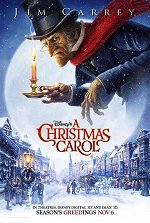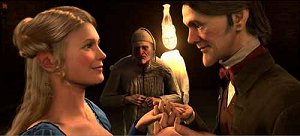 |
|
At The Picture Show
|
November 2009
Humbug
Modern technology undermines a traditional tale, as motion-capture and 3-D derail 'A Christmas Carol'

A Christmas Carol
Walt Disney Pictures
Director: Robert Zemeckis
Screenplay: Robert Zemeckis, based on the novella by Charles Dickens
Starring: Jim Carrey, Gary Oldman, Colin Firth, Bob Hoskins, Robin Wright
Penn and Cary Elwes
Rated PG / 1 hour, 36 minutes
Opened November 6, 2009

 (out of four)
(out of four)
Here's a lesson. When the entirety of your idea for a movie is, "I can do that in
motion-capture," that's not an idea. It's just an excuse to play around with your
favorite new gadgets, at the expense of . . . well, everything else.
A movie like this - Robert Zemeckis' 3-D, motion-capture adaptation of Charles
Dickens' A Christmas Carol - is what you get when you care infinitely more about
shoving a gimmick down our collective throat than with telling a story. This is not
a style-over-substance issue (an argument I always loathe anyway), but simply a
matter of propriety. If we're talking about a purely experimental film - where the
very point is supposed to be applications of form and technique and technology -
then that's one thing. But Zemeckis' experiments are something much different.
They masquerade as worthwhile stories, but instead play like glorified demo reels
for two kinds of crappy technology.
 Case in point, A Christmas Carol, whose
sole selling point is that it's such a classic story - "reimagined," they say. Yet the
entirety of that "reimagination" is utilizing the distraction that is motion-capture,
removing all the humanity and warmth from a story built on humanity and warmth.
The result is a Lucas-esque disparity between a filmmaker's affection for his pet
technology vs. that for every other conceivable element. In Zemeckis' motion-captured, 3-D world, everything is peripheral except for the gimmicks themselves.
Case in point, A Christmas Carol, whose
sole selling point is that it's such a classic story - "reimagined," they say. Yet the
entirety of that "reimagination" is utilizing the distraction that is motion-capture,
removing all the humanity and warmth from a story built on humanity and warmth.
The result is a Lucas-esque disparity between a filmmaker's affection for his pet
technology vs. that for every other conceivable element. In Zemeckis' motion-captured, 3-D world, everything is peripheral except for the gimmicks themselves.
You can tell while watching A Christmas Carol that Zemeckis is mailing in the
story. He doesn't care about it one iota. If you read the script by itself, you'd
wonder why in the world this movie was being made in the first place. The
majority of the film's scenes and dialogue are practically verbatim from other
versions. That's not an issue of adaptation, it's an issue of disinterest or apathy. If
he's just going to repeat the same thing we've seen for decades, why tell this story
in the first place?
Oh, that's right - because it's in motion-capture this time! Wheeee!
 And that's precisely my point. Motion-capture for humans hasn't gotten much better - the characters we know so well
from Dickens' novella are the same Creepy Dead-Eyed Animatronic Zombie
Freaks (TM) that we saw in Zemeckis' abysmal The Polar Express and
miscalculated Beowulf. They are an intrusion on our senses - lifeless characters
acting out a lifeless film. Their movements remain unnatural and awkward, their
eyes remain dead, their very presence mocks the animated reality that has been
created for them. I know the motion-capture gimmick gives actors like Jim Carrey
and Tom Hanks and Ray Winstone a chance to look unrecognizable in a way that
traditional makeup cannot, but at what cost?
And that's precisely my point. Motion-capture for humans hasn't gotten much better - the characters we know so well
from Dickens' novella are the same Creepy Dead-Eyed Animatronic Zombie
Freaks (TM) that we saw in Zemeckis' abysmal The Polar Express and
miscalculated Beowulf. They are an intrusion on our senses - lifeless characters
acting out a lifeless film. Their movements remain unnatural and awkward, their
eyes remain dead, their very presence mocks the animated reality that has been
created for them. I know the motion-capture gimmick gives actors like Jim Carrey
and Tom Hanks and Ray Winstone a chance to look unrecognizable in a way that
traditional makeup cannot, but at what cost?
In the case of these movies, a pretty hefty one. After just a few minutes of
watching them flounder as computerized automatons, you just feel bad for them.
You start to think how even the hand-drawn animation that so many now consider
"primitive" would be a welcome respite. You cringe at the hypothetical, "What if
Zemeckis had made Who Framed Roger Rabbit now instead of 20 years ago?"
You ask yourself, "Who would have been motion-captured - the humans or the
toons?" And then you choke at the thought of the recently announced Roger
Rabbit sequel.
Or maybe that's just me. I digress.
An even worse - though optional - element of A Christmas Carol is its 3-D
presentation, which I had the misfortune of seeing. Once again, I was in awe at the
extent to which the process dilutes colors, destroys clarity of vision and blurs
movement. And that's not even getting into the irritation at having fake digital
snowflakes falling in your face.
 Carrey does what he can with the role of
the miser Ebenezer Scrooge, but the script proves nearly as stifling as the
technology on display. Scene after scene feels like little more than an all-too-familiar line reading. There is never any motive for anyone's actions or feelings -
they're there out of fidelity rather than necessity. The film plows through its story
like a freight train - the memories we see courtesy of the Ghosts of Christmas Past
and Present are nothing more than brief, half-baked episodes that leave little to no
impact - so brief and meaningless, in fact, that they border on the absurd.
Carrey does what he can with the role of
the miser Ebenezer Scrooge, but the script proves nearly as stifling as the
technology on display. Scene after scene feels like little more than an all-too-familiar line reading. There is never any motive for anyone's actions or feelings -
they're there out of fidelity rather than necessity. The film plows through its story
like a freight train - the memories we see courtesy of the Ghosts of Christmas Past
and Present are nothing more than brief, half-baked episodes that leave little to no
impact - so brief and meaningless, in fact, that they border on the absurd.
I'll give Zemeckis credit where he earns it - he can still create some striking
images. There are moments and creations of macabre beauty and some fine details
in the production design. I enjoyed the visual representation of each of the three
spirits that visit Scrooge - in particular Christmas Past, who is basically an
anthropomorphized candle. By even awarding A Christmas Carol two stars, I'm
meeting it halfway - mostly on the strength of some of its visuals and the fact that I
didn't get the chance to see it in glorious 2-D.
Then again, the film's total lack of purpose and irritating motion-capture don't give
me any further motivation to do so. I'll stick with the original Dickens, thank you
very much.
Read more by Chris Bellamy